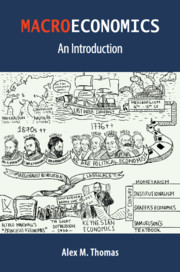Book contents
- Frontmatter
- Dedication
- Contents
- List of Illustrations
- List of Figures
- List of Tables
- Preface
- Acknowledgements
- Note to the Reader
- 1 What is Economics
- 2 Conceptualising the Macroeconomy
- 3 Money and Interest Rates
- 4 Output and Employment Levels
- 5 Economic Growth
- 6 Why Economic Theory Matters
- 7 The Policy Objective of Full Employment
- 8 The Policy Objective of Low Inflation
- 9 Towards Good Economics
- Data Sources
- References
- Index
2 - Conceptualising the Macroeconomy
Published online by Cambridge University Press: 08 June 2021
- Frontmatter
- Dedication
- Contents
- List of Illustrations
- List of Figures
- List of Tables
- Preface
- Acknowledgements
- Note to the Reader
- 1 What is Economics
- 2 Conceptualising the Macroeconomy
- 3 Money and Interest Rates
- 4 Output and Employment Levels
- 5 Economic Growth
- 6 Why Economic Theory Matters
- 7 The Policy Objective of Full Employment
- 8 The Policy Objective of Low Inflation
- 9 Towards Good Economics
- Data Sources
- References
- Index
Summary
Introduction
What do you think are the relevant aspects of a macroeconomy that can be utilised in the first stage of theorising? Should we try to classify households as rich and poor or treat them as if they are a single homogenous unit? Should we distinguish between local governments and the central government? Should we begin with a classification of firms as capital intensive and labour intensive? Or should we distinguish firms that cater primarily to the rest of the world from those that cater to the domestic economy? While all these are indeed important aspects of a macroeconomy, in this chapter you will soon see that these are not treated as relevant in the first stage of theorising.
This chapter takes you through a quick chronological tour of both the past and present of conceptualising the macroeconomy starting with William Petty in England and ending with V. K. R. V. Rao and P. C. Mahalanobis in India. After introducing you to three distinct ways of conceptualising the macroeconomy, the macroeconomy itself is conceptualised as being embedded within the larger domains of society and ecology. Subsequently, the economy is treated as a web of dual flows of commodities and money moving across the following key sectors: households, financial, non-financial and government. The chapter ends by making explicit the nature of abstraction employed in this book. And as with any theory which is necessarily abstract, its application to the actual world must be undertaken with great caution.
Conceptualising the macroeconomy: past and present
Understanding the macroeconomy requires that it be conceptualised. This calls for the identification of its boundaries and the relevant organs/parts. Since this book defines economics as the science of wealth and adopts a macro approach, certain forms of conceptualising the macroeconomy and the measurement of wealth and income are warranted. Henceforth, I shall use ‘the macroeconomy’ and ‘the economy’ interchangeably because the usual way of expressing the idea of a macroeconomy is through the term ‘the economy’. The economy has been and can be conceptualised and understood by focusing on the following relevant aspects: (a) aggregate income and expenditure, (b) inter-sectoral relations and (c) the flow of funds across sectors.
- Type
- Chapter
- Information
- MacroeconomicsAn Introduction, pp. 20 - 38Publisher: Cambridge University PressPrint publication year: 2021

